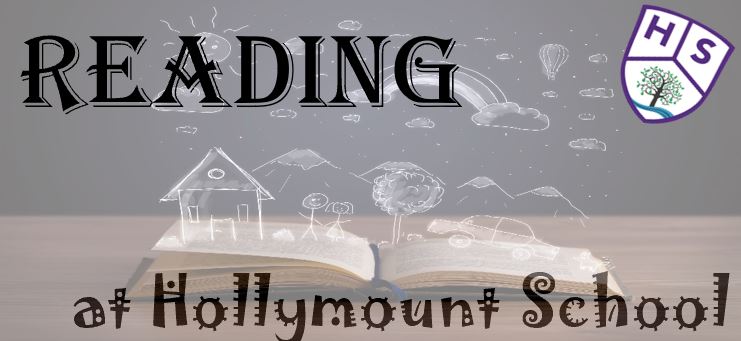
Intent
By the time children leave Hollymount School, they leave as readers. Readers who have developed a lifelong love of reading; and readers who read because it is how they can learn more about the world around them. We will have provided children with the tools to fully and confidently access the secondary curriculum and we firmly believe that the ability to read underpins all other areas of learning.
At Hollymount, we believe that children’s cognitive demand must change in order to ‘master’ the skill of ‘deeper’ reading. By which we mean, not just decoding but comprehending. When responding to a text, it is essential that they can justify, reason and back up their answers with evidence or opinions. At Hollymount, we believe there are three elements that need to come together in order to access this deeper level of understanding: knowledge of the world, stylistic knowledge and retrieving and summarising information. A “thinking out loud” approach underpins our reading pedagogy in order to bring these three elements together. Through this approach, our children develop into confident and independent readers, with high levels of enjoyment and comprehension.
Implementation
High-quality ‘reading lessons’ start in Nursery where children focus on letters and sounds phase one. This concentrates on developing children’s speaking and listening skills and is divided into 7 aspects, including general sound discrimination, rhythm and rhyme, alliteration, voice sounds and oral blending and segmenting. Their love of reading is nurtured and developed by introducing them to traditional nursery rhymes, songs and stories.
The Phonics Handbook outlines how phonics teaching starts more formally starts in reception (using the RWI programme) and continues until children can decode confidently. Children only come off the RWI programme when they have reached the grey group. This means they can read 80+ words a minute and can attempt to read with intonation to show comprehension. It is expected that this will happen in year 2, although we accept this may not be the case for all children. Phonics and reading lessons are taught at the same time across the school to allow children to fit into whichever group best suits their ability.
After children complete the RWI phonics programme, there is an increased focus on their comprehension skills. In years 2 and 3, children undertake a comprehension programme of study to bridge the gap between RWI phonics and KS2 Comprehension X. This programme of study involves developing their comprehension skills whilst inspiring a love of reading. Whilst we continue to review the set 2 & 3 speed sounds, we work systematically to develop specific reading comprehension skills, which are based on 5 ‘reading pups’. Each character represents a specific reading skill, such as Rex Retriever, Predicting Pup and Inference Iggy. Towards the end of year 2, children begin to make explicit links between these the ‘expert tips’ used in KS2.
Delivery of reading lessons in KS2 hooks on ‘expert tips’, which originate from the Comprehension X scheme. Year 3 children are still unable to undertake the Comprehension X Scheme (as this is only aimed at years 4, 5 and 6), however, they use the expert tips within their reading lesson. Years 4, 5 and 6 all start with the delivery of Comprehension X in the Autumn Term. When the scheme is completed, the children then continue to use the ‘expert tips’ within their reading lessons. Further information about this can be found in the Reading Handbook.
All children are exposed to a rich, varied reading diet, which includes a range of special books (selected from Pie Corbett’s reading spine); key authors; poetry; and non-fiction texts . This is either through their reading lessons or as whole class texts – which are read purely for pleasure.
